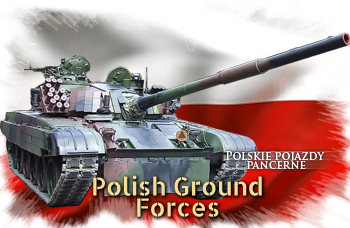
About 5,000 armoured vehicles 1947-1990.
Articles:Cold war
The Polish Army in ww2
Poland made of the opening of world war two with a large standing army and nearly 500 tanks, but it was not enough to face the Wehrmacht and even less to face the Red Army attacking from the east, following the secret protocol established after the signature of the non-aggression pact on 23 August. Despite a resolute and brave defense, the Polish Army was overwhelmed. The surrender did not stop Poland to fight, however, first in the air over Great Britain, and then with the British Navy, in North Africa, and gradually in Italy with much superior forces. By the fall of 1944, a full armored division and several infantry divisions were constituted. For more, see the page covering the 1920-1945 era, ww2 polish tanks.After the liberation of Poland by the Red Army, a new provisional pro-communist government was established and in mid-1945 a brand new Polish Army rearmed with Soviet tanks branded with the Polish eagle participated in the final offensive in sectors let down by Soviet forces previously. To the dismay of officers and men which fought together with the allies when the war was over and after peace transactions with Stalin, Poland found itself inside the Soviet sphere of influence, perhaps as a token of appeasement for what was still an ally then. Poland then gradually set up its own tanks industry, producing in the 1970s thousands of T-54, 55, and T-72s together with Czechoslovakia, becoming the main provider of Tanks and AFVs among Warsaw Pact countries. This experience and assets were still there when the Soviet Union collapsed.
Models
With massive quantities of weaponry, including Soviet tanks provided by USSR at the end of World War II, Poland as a satellite state and within Soviet sphere of influence was able to quickly create a potent Armoured Force. The Polish army was until the early 1950s under the command of Marshal Konstantin Rokossovsky, with the title "Marshal of Poland", also Minister of National Defense. His ties with Moskow ceased after the Polish October political movement in 1956.- Polish modified T-34/85 M1/M2: Poland had about 1,000 T-34/76 and T-34/85 in the 1950s. The T34/76 were scrapped or converted while the T34/85 were gradually modernized.
- Polish built WTP-34 engineering vehicle.
- Polish-built T-54/55: Also comprised the T-55A, T-55 AM Merida, T-55AD-2M (command), T-55AMS, T-55AD-1M
- Polish built T-72M/T-72M1 (Bumar-Łabędy plant, Gliwice, 1982), T-72M1D (command variant)
- Polish built WZT-3 (1989): ARV based on the T-72M and its 1990-2000s export variants
- Polish built SJ-09, driver training vehicle.
- Polish built BWP-1, local modernized variant of the BMP-1. Also comprises the modern BWP-1M "Puma 1".
- Polish built 2S1 Goździk, local variant of the 2S1 Gvodzika SPG
- Polish built Opal, local variant of the MT-LB tractor, also the ZWD-1, Lotos, Przebiśnieg and other sub-variants
- Polish built OT-64 Skot, Custom APC built with Czech components
- Polish built LPG based on the Opal, artillery command vehicle (modern)
- Polish built ZWDSz 1, local version of the MT-LBu by Huta Stalowa Wola S.A. (modern)
Poland and the Warsaw Pact
Under a new leadership the country was now narrowly linked to the line defined in Moskow, and in 1947 the Cold War was on, as events in Berlin degenerated quickly. The Warsaw pact also officially known as the Treaty of Friendship, Co-operation, and Mutual Assistance, was a reaction to the constitution of NATO in 1955. It was signed on 14 May the same year and Gathered East-European nations previously liberated by the Red Army, namely Bulgaria, Romania, Yugoslavia, Albania, Hungary, Czechoslovakia, East Germany and of course Poland, as the treaty was signed in its capital. This treaty and organization will be the black beast for NATO until 1990. It was at first the traduction of countries armed with the same standards in equipment, tactics and operating procedures. But as times goes by, some nations developed gradually their own production (license production and derivatives) especially industrial nations like Poland, Czechoslovakia, Hungaria, Romania. Tito's Yugoslavia took a radical departure early on and never joined the treaty.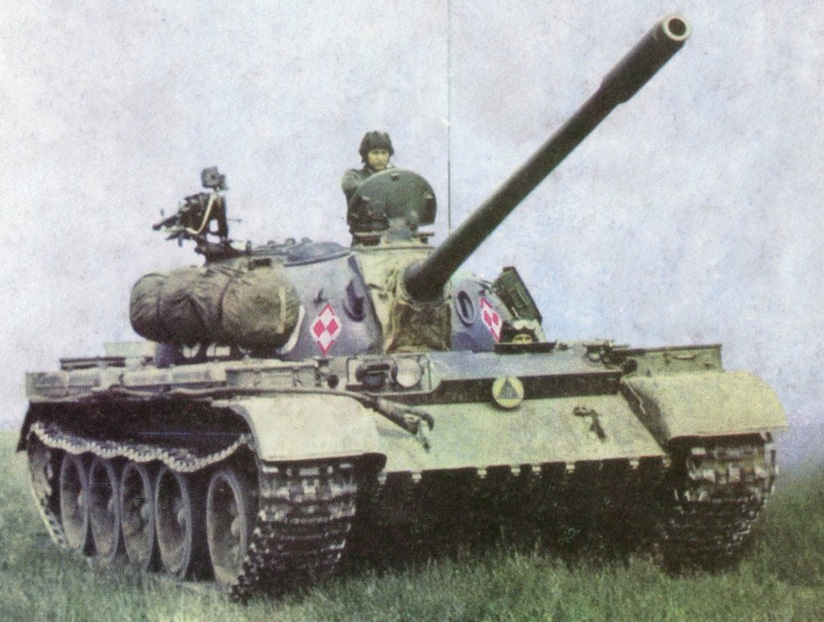
A Polish-built T-54AM. They had "L"-shaped fuel cells and additional ZIP stowage bins on either side of the turret.
The LWP (Polish Army) took part in the suppression of the 1968 Czechoslovakian revolt, the famous "Prague Spring". Columns of tanks and motorized rifle troops headed toward Prague and other cities, meeting no resistance. The bulk of it were the 28,000 troops of the 2nd Army, Silesian Military District (general Florian Siwicki).
About the Polish People's Army Land Forces
The Polish ground army was subdivided between the:Pomeranian Military District
(6th Pomerania Air Assault Division and 7th Łużycka Naval Assault Division, Warsaw Engineer Brigade, 14th Sudecki Anti-tank Artillery Regiment and 15th Antitank Artillery Regiment)-8th Dresden Mechanized Division
-12th Szczecin Mechanized Division
-15th People's Guards Mechanized Division
-16th Kaszubska Armored Division
-20th Warsaw Armored Division
Silesian Military District
-2nd Warsaw Mechanized Division-4th Pomerania Mechanized Division
-5th Saska Armoured Division
-10th Sudeten Armoured Division
-11th Dresden Armored Division
-20th Anti-tank Artillery Regiment
Warsaw Military District
-1st Warsaw Mechanized Division-3rd Pomerania Mechanized Division
-9th Mechanized Division
-2nd Warszawska Engineer Brigade
-80th Anti-tank Artillery Battalion
In addition there was the Polish Territorial Defense Forces, with its Headquarters in Warsaw:
These internal Defense Forces of the Ministry of National Defense, comprising 4 infantry brigades and a regiment, 1 logistic brigade under the National Defense Commission and the State Committee for Territorial Defense, the four regiments of the Ground defense units of the IDF and a Pontoon Unit, plus three regiments of IDF Engineering and Rescue equipped with armoured vehicles.
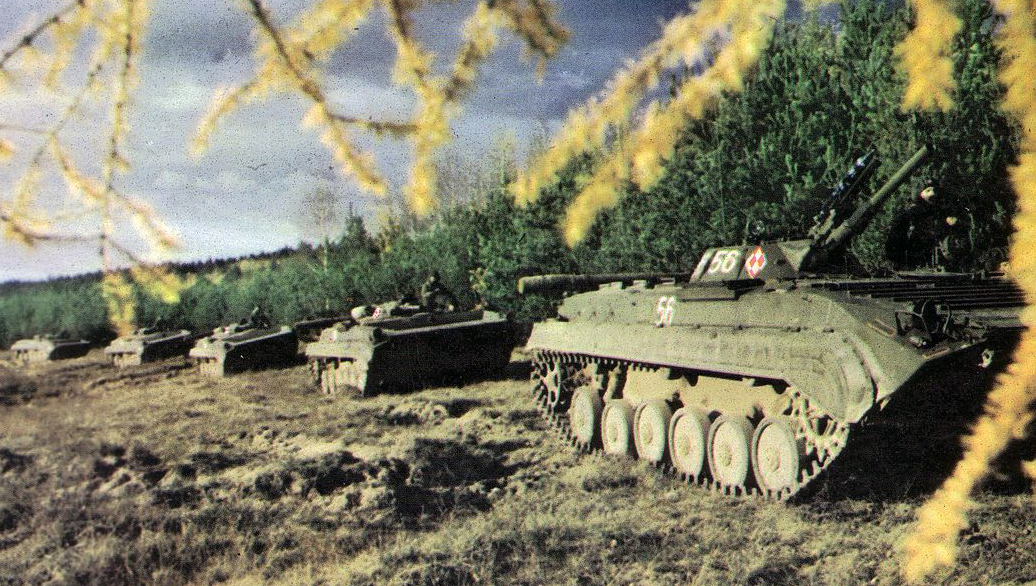
Polish BWP-1s in manoeuvers in the 1980s

A Polish-built T-54AM. They had "L"-shaped fuel cells and additional ZIP stowage bins on either side of the turret.
Birth of a new Polish military industry
Although procedure and tactics were borrowed from Soviet Union instruction and defined also by similar equipment, the local industry soon found ways already in the 1960s to license-produce Soviet tanks for the Polish People's Army. Indeed, 2,855 Polish T-54AMs were manufactured in the Bumar-Labedy from 1956 to 1967, differing by minor details for Soviet tanks. They formed the backbone of the Polish Army, replacing older T-34/85s.The end of the cold war (1980s)
The 1980s political events were instrumental in Poland's history as they certainly contributed to a loss of authority from Moskow and was one of the knockdown blows that bring the Soviet empire to collapse in 1989-90. The Solidarnosz (an independent trade union) movement funded 17 September 1980 at the Gdańsk Shipyard under the leadership of Lech Wałęsa came as a revelator of the will of independence that surged in many eastern block countries at large.The movement grew up to create massive strikes in 1988, and despite the reaction of the regime led by hard-liner Marshal Jaruzelski in ended in September when the local communist party was forced to recognise the movement as a political party of its own, and the next year the first national elections were organized in June 1989, which led to the victory of Lech Wałęsa (which became later the first president of post-cold war Poland and new Senate). The disintegration of the USSR later only confirmed both a full independence of Poland and its opening to the West.
In all these events, the Army seemed neutral, although subjugated by Marshal Jaruzelsk an , intervention was feared but never appeared as it seemed no order were given to make a "crowd-control" in the old Soviet style, with tanks rolling in the streets and over barricades. In the following years, the Army was left with an obsolescent, massive park of AFVs and little funds that imposed a deep re-organization.
The end of the cold war (1980s)
The 1980s political events were instrumental in Poland's history as they certainly contributed to a loss of authority from Moskow and was one of the knockdown blows that bring the Soviet empire to collapse in 1989-90. The Solidarnosz (an independent trade union) movement funded 17 September 1980 at the Gdańsk Shipyard under the leadership of Lech Wałęsa came as a revelator of the will of independence that surged in many eastern block countries at large.The movement grew up to create massive strikes in 1988, and despite the reaction of the regime led by hard-liner Marshal Jaruzelski in ended in September when the local communist party was forced to recognise the movement as a political party of its own, and the next year the first national elections were organized in June 1989, which led to the victory of Lech Wałęsa (which became later the first president of post-cold war Poland and new Senate). The disintegration of the USSR later only confirmed both a full independence of Poland and its opening to the West.
In all these events, the Army seemed neutral, although subjugated by Marshal Jaruzelsk an intervention was feared, but never appeared as it seemed no order were given to make a "crowd-control" in the old Soviet style, with tanks rolling in the streets and over barricades. In the following years, the Army was left with an obsolescent, massive park of AFVs and little funds that imposed a deep re-organization.
In the late 1980s the Polish Army modernized all of its obsolete park of T-55 tanks to the T-55AM Mérida standard. This successful conversion convinced the Polish General Staff that other Soviet-designed models manufactured locally cold follow, better suited to the requirements of the Polish Armed Forces. By late 1988, modernization of the Polish-built T-72M1 (obiekt 172M-E5) licensed T-72M or obiekt 172M-E3 an the sub-variant command tank T-72M1K (Polish designation T-72M1D). The Polish Research and Development Centre of Mechanical Systems or "OBRUM" (for Ośrodek Badawczo-Rozwojowy Urządzeń Mechanicznych) base din Gliwice, was chosen as design bureau, somewhat underfunded as Generals still looked to acquired instead Soviet last upgrades of the T-72 such as the T-72S or even the modern T-80.
After the political changes of 1989 and USSR dissolution, all purchases came to a halt. Domestic design of a new Polish tank was now favoured and given full support at all levels. The first design was the "Wilk" ("wolf"), later cancelled and further developed as the Twardy. The monumental task was to offer the Polish Army with a new version adapted to modern warfare. Fixes concerned its most urgent deficiencies such as mobility, armour, fire control and gun stabilisation as well as night vision aiming systems. A local electronics industry soon developed to support the project.
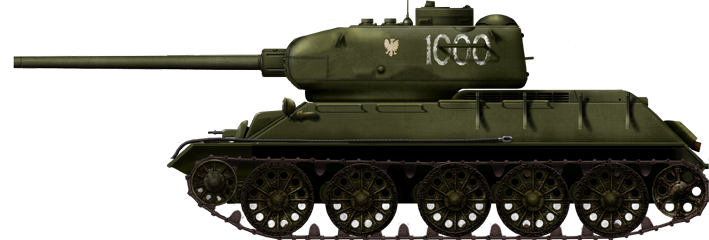
T-34/85 Poland operated some 1,000 T-34, mostly of the Type 85, modernized.
Some were of the model 1946 (Improved V-2-34M engine, new wheels, and details), But it seems it was modified locally as the M1 equivalent to the Soviet Model 1960 (refurbishing program with the V-2-3411 engine an other details). The most advanced, modernized for export, was called Model 1969 (T-34-85M) with night driving equipment, T-54/55/62 standard stamped roadwheels, additional fuel and the 1960 upgrades) but the Polish version was different (called M2).
The Polish T-34-85M1 was locally refurbished and Similar to the Soviet Model 1960, but recoignisable to its 'skeleton' type roadwheels. The T-34-85M2 was the Polish refurbished model parralel to the Soviet Model 1969, which had extra exterior storage, but also a deep-wading kit and snorkel, and still the old "spider" style roadwheels. In addition to these versions, Poland also developed derivatives, such as the CW-34, a local variant of the VT-34, and the WPT-34 in the 1960s, the main Polish repair and maintenance vehicle.
It was given a brand new superstructure comprising a a crane, large-diameter telescoping snorkel and a large-spade type earth anchor at the rear. This convertion was also applied to older T-34 tanks in mark and SU-85/SU-100 tank destroyers as well. This success conducted to more engineering vehicles in the future, based on the T-55 such as the WZT-1/2 ARV/CEVs, IWT dozer/crane and BLG-60 AVLB (see below).

Polish T-34/85M2

Polish WTC-34 engineering vehicle

IS-3 Poland only received 2 IS-3s for testing and never introduced the type into service. However, one is kept at the Polish Armor Museum, having a marking with the Polish eagle.
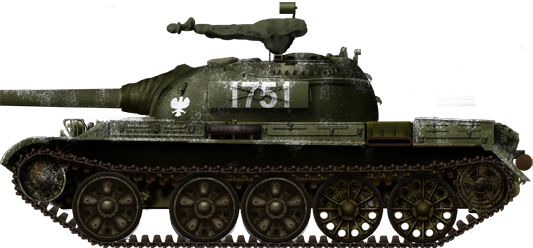
T-54 Here a Polish-built T-54AM. These were produced by the thousands, and had significant differences, two locally-designed "L" shaped fuel cells (left fender), modified right rear air intake, different tool box storage, new rotating turret floor, and modified hydraulically assisted drive's controls. Most were exported.

T-72 Polish-built T-72A Jaguar. This Polish-built model was licence-produced since the late 1970s, mostly for export. Building quality was a plus compared to Soviet manufacturing standard and these were well received. Polish-made T-72G tanks had thinner armour compared to Soviet Army standard (410 mm equivalent for the turret). It is interesting to note that Polish Colonel Ryszard Kukliński passed to the CIA between a lot of documentation about the T-72 between 1971 and 1982. He fled to the US after being denounced, exfiltrated by the CIA. The M1 was built under licence by Bumar-Łabędy in Gliwice from 1982. They had rubber side skirts and 902W Tucha smoke grenade launchers.
Late production models had an extra 16 mm steel plate on the upper glacis. The T-72M1 was the export version of the T-72A licenced in Poland (1983) with less KMT mounting points on the lower hull glacis plate. It had ceramic sand bars "kwartz" rods in the turret cavity, and the extra plate 16 mm (0.63 in) thick of special Steel as appliqué armor on the glacis. T-72M1D was its command variant. In 2009, there were still about 580 T-72 in service with Polish Forces: of which 135 were T-72A, 254 T-72M1 and 23 T-72M1. Poland also developed the greatly improved SJ-09 and “Wilk” prototypes for a future domestic production and as modernization upgrades for customers. This ended with the development of the domestic PT-91. However these were replaced gradually by German-built Leopard II tanks in the 2000s.
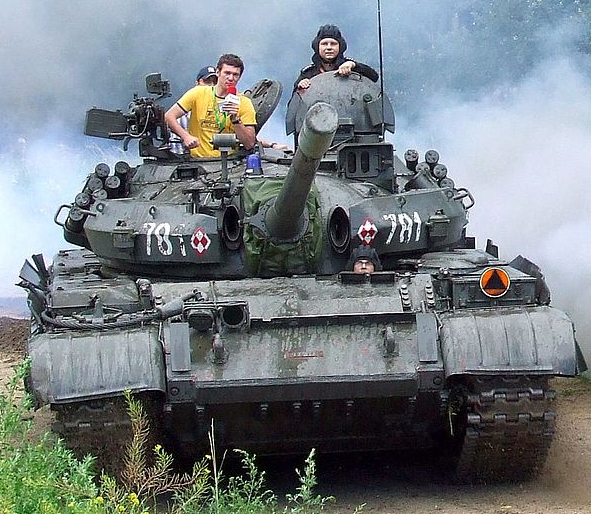
T-55Also built under licence in Poland. Combined with Czechoslovakia, this was a staggering total of 21,000 more tanks. Modifications includes the T-55AD command tank (161 km radio range), T-55L (local T-55A) and T-55LD (rebuilt T-54), T-55AD-1 & 2 (A command tanks with additional radios). In the 1980s a second wave of modernizations concerned the T-55AM "Merida" (Sub-variants: T-55AMS, AD-1M & AD-2M command). Others includes the S-125SC "Newa-SC" SPAAML, WZT-1/2 ARV/CEVs, IWT is the standard dozer/crane BLG-60 bridgelayer.
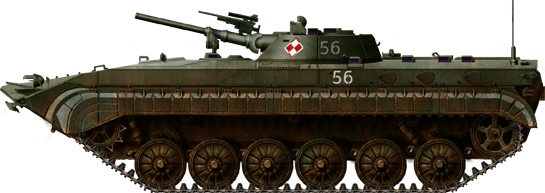
BWP-1 The Soviet IFV BMP-1 was also licence-built in Poland. In the 1990s, alongside the BMP-1M Puma appeared numerous variants such as the BWP-40 combiing the CV9040 turretwith its hull (1993 prototype), the BWP-95 with an overhead 23 mm cannon mount and recoilless rifle on a slab mantlet fitted to the turret front, and MB smoke grenade launchers, and ERA (prototype). Also were produced the BWR-1S Reconnaissance Fighting Vehicle, loval version of the Czechoslovak BPzV "Svatava", the BWR-1D (Recced Command) similar to the BRM-1K, the ZWDSz-2 (Automated Staff Command Vehicle), a Modernised MP-31 with TRC 9500 (VHF) and RF-5200 (HF) radios, TDR-20K computer, AP-82, AP-92 and CAT-U telephones, RK-128/2 generator, but no telescopic mast. Also the BWP-1S had two thermal imagers, two TV cameras, a laser rangefinder, an artillery fire detector, new radios, GPS satellite navigation system, smoke screen generator, data transmitting unit, camouflaging coating among others. It is the 2000s model proposed as an upgrade package for export; Also the BMP-1AK was a derived sub-variant with improved internal layout, additional anti-HEAT protection, improved night vision, new tactical radios.
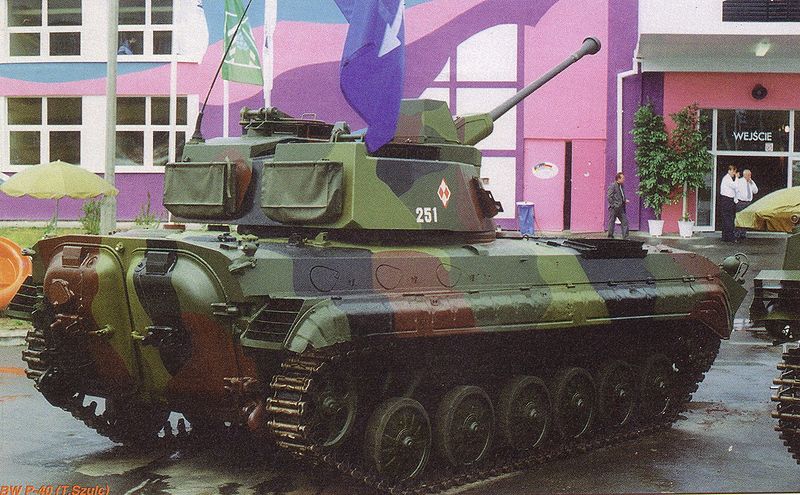
Polish BWP-40 SPAAG variant
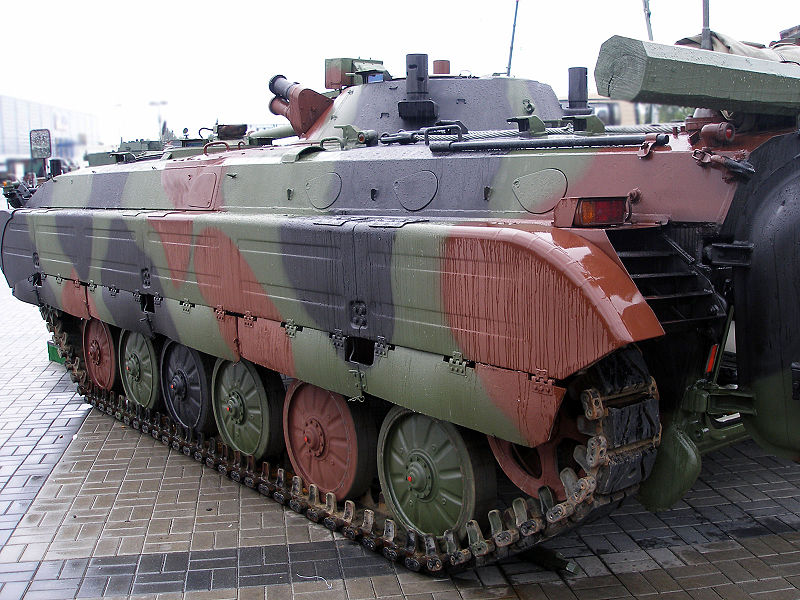
Polish BWP-1M Puma, the modernized IFV proposed in mutiples variants
MT-LB & 2S1 Gvozdika (as well as other related vehicles such as the MT-LB and Opal) were produced in Poland by Huta Stalowa Wola under the name 2S1 Goździk. 2S1M Goździk – Version with special amphibious kit that increases the vehicle's amphibious capabilities. The 2S1T Goździk was a Version with a TOPAZ digital fire control system from WB electronics. The system consists of a FONET-IP digital intercom system, new digital radio, military GPS receiver, military computer and dedicated software. The same system is used on other Polish Armed Forces artillery systems like the AHS Krab, Dana-T and WR-40 Langusta.
BTR-60/70: Poland also operated these, like the local BTR-60PB with an additional radio set, and a few population control vehicles were built, fitted with a two-sided breaker, urban protection, OU-3 infrared searchlight, operated by the The Milicja Obywatelska and ZOMO units, and the Polish Ministry of Internal Affairs operated 25 vehicles later, little are now in service. Instead, Poland built and used the OT-64. Another lighter vehicle also used was the Hungarian-built FUG-440, close to the BRDM-2 (also used by Poland and modernized).
Equipments of Poland in the Cold War

Polish licence-built T-72A in the early 1980s

Polish licence-built and locally modified T-72M1 in the 1990s

IS-3Poland only received 2 IS-3s for testing and never introduced the type into service. However, one is kept at the Polish Armor Museum, having a marking with the Polish eagle.

T-54 Here a Polish-built T-54AM. These were produced by the thousands, and had significant differences, two locally-designed "L" shaped fuel cells (left fender), modified right rear air intake, different tool box storage, new rotating turret floor, and modified hydraulically assisted drive's controls. Most were exported.

T-55 Also built under licence in Poland. Modifications includes the T-55AD command tank (161 km radio range), T-55L (local T-55A) and T-55LD (rebuilt T-54), T-55AD-1 & 2 (A command tanks with additional radios). In the 1980s a second wave of modernizations concerned the T-55AM "Merida" (Sub-variants: T-55AMS, AD-1M & AD-2M command). Others includes the S-125SC "Newa-SC" SPAAML, WZT-1/2 ARV/CEVs, IWT is the standard dozer/crane BLG-60 bridgelayer.

Polish T-72 JaguarThe T-72 was license-produced in Poland since the late 1970s, chiefly for export. In 2009, about 580 T-72 were in service: 172 T-72s, 135 T-72A, 254 T-72M1 and 23 T-72M1 plus some SJ-09 and "Wilk" prototypes. Many were converted as PT-91s, sold or kept in storage, being replaced by the Leopards.
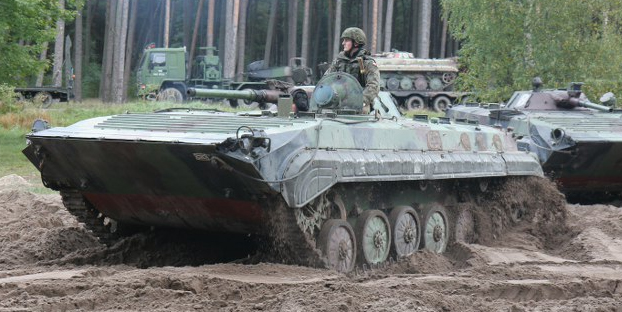
BWP-1 The locally-designated BMP-1 since the 1970s. 1400 were ordered in 1969. Now less than 800 are still operational, and a few are declined into the BWP-1D (33), BWR-1D (22) and BWR-1S (16) specialized variants. Pending replacement by the PL01.
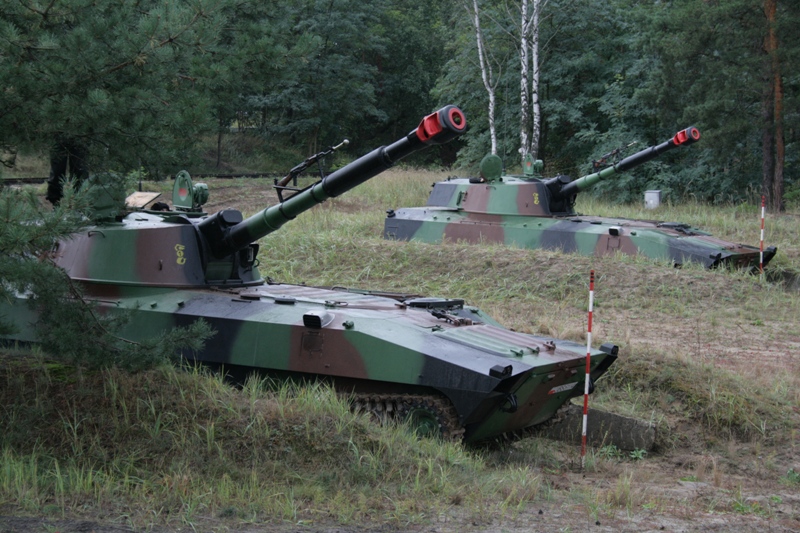
2S1 Gvoździka The cold war legacy Polish self-propelled artillery fleet comprised 324.
111 wheeled Wz. 1977 Dana (Czech-built).
Read More
Polish Armed ForcesEquipments of the Polish Forces
The Polish Land Forces
Official website
key.aero
Opal APC
List of equipment of the Polish Land Forces

Cold War Tanks


































Cold war tanks posters

Cold War Main Battle Tanks

Cold War Soviet Army
